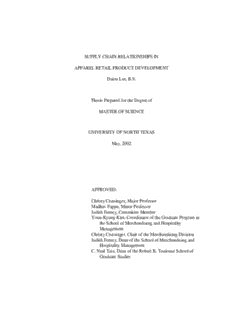
Supply chain relationships in apparel retail product development. PDF
Preview Supply chain relationships in apparel retail product development.
SUPPLY CHAIN RELATIONSHIPS IN APPAREL RETAIL PRODUCT DEVELOPMENT Daton Lee, B.S. Thesis Prepared for the Degree of MASTER OF SCIENCE UNIVERSITY OF NORTH TEXAS May, 2002 APPROVED: Christy Crutsinger, Major Professor Madhav Pappu, Minor Professor Judith Forney, Committee Member Youn-Kyung Kim, Coordinator of the Graduate Program in the School of Merchandising and Hospitality Management Christy Crutsinger, Chair of the Merchandising Division Judith Forney, Dean of the School of Merchandising and Hospitality Management C. Neal Tate, Dean of the Robert B. Toulouse School of Graduate Studies Lee, Daton, Supply chain relationships in apparel retail product development. Master of Science (Industrial-Technical Merchandising & Fabric Analytics), May 2002, 86 pp., 2 tables, 3 figures, references, 54 titles. The purpose of this study was to investigate supply chain relationships within the apparel retail product development process under a single site case study setting. Relationship determinants (i.e. drivers, facilitators and barriers) that facilitated or impeded the degree of collaborative efforts between the retailer and the supply chain members were identified. As the retailer integrated its product development process with its suppliers, a triangular relationship was formed between the retailer, the overseas manufacturers, and the designated suppliers. The study found that the retailer sought operational efficiency in its business relationships with supply chain members, but continued to seek long-term commitment in these relationships to establish a virtual vertical company. Copyright 2002 by Daton Lee ii ACKNOWLEDGMENTS I would like to thank Dr. Christy Crutsinger for her encouragement and support. Without her guidance, I would have never been able to finish this project. I would also like to acknowledge Dr. Judith Forney and Dr. Madhav Pappu for serving on my committee. Their feedback was invaluable. A special thanks to Arlene Clemente for her enthusiasm and her efforts in coordinating the data collection process. Most of all, I am sincerely grateful for my mother who always encourages me to pursue education, and Grace who never stops pushing me to do my best. iii TABLE OF CONTENTS Page ACKNOWLEDGEMENTS............................................................................................. iii LIST OF TABLES........................................................................................................... vi LIST OF FIGURES.......................................................................................................... vii Chapter I. INTRODUCTION.......................................................................................... 1 Rationale of the Study Purpose of the Study Limitations Assumptions Operational Definitions II. REVIEW OF LITERATURE........................................................................ 7 Introduction Apparel Industry and Private Label Merchandise Apparel Retail Product Development Model Supply Chain Management Partnerships Types of Partnerships Drivers, Facilitators, and Barriers Inter-Organizational Relationships Product Development Relationships Supplier-Retailer Relationships Conceptual Framework Summary III. METHODOLOGY......................................................................................... 29 Research Questions Case Study Site Selection iv Instrument Data Collection Pilot Interview On-site Data Collection Data Analysis Validity and Reliability IV. RESULTS AND DISCUSSION.................................................................... 38 Apparel Product Development Organization Internal Apparel Product Development Organization External Product Development Network Supply Chain Relationship Determinants Drivers Facilitators Barriers Supply Chain Relationship Orientation V. SUMMARY, CONCLUSIONS, AND RECOMMENDATIONS................. 60 Summary Conclusions Triangular Relationship Relationship Determinants Supply Chain Linkages Recommendations APPENDICES................................................................................................................. 72 A Use of Human Subjects Informed Consent Form B Semi-structured Interview Questions C Conceptually Clustered Matrix: Drivers, Facilitators, and Barriers REFERENCES................................................................................................................ 81 v LIST OF TABLES Table Page 1. Interviewees by Departmental Functions and Management Levels........................... 35 2. Relationship Determinants: Drivers, Facilitators, and Barriers................................. 47 vi LIST OF FIGURES Figure Page 1. Conceptual Framework of Supply Chain Management in the Apparel Retail Product Development Process................................................................................................. 26 2. Apparel Product Development Organization............................................................. 40 3. Supply Chain Relationships in Apparel Retail Product Development...................... 67 vii CHAPTER I INTRODUCTION Constantly changing styles of fashion apparel and growing diversification of consumer preferences create a keen competitive environment in the apparel retailing industry. As a result of increasing competition, many businesses seek to differentiate and create competitive advantages over rival companies. One successful strategy is through product differentiation (Gaskill, 1992; Richardson, 1996; Wickett, Gaskill & Damhorst, 1999). The unique nature of the apparel industry results in the continuous introduction of new products into the market. Nonetheless, developing new products is no longer an exclusive responsibility for apparel manufacturers. Retailers are proactively creating their own private apparel brands (Abend, 2000). According to Abend (2000), about 15% to 25% of apparel merchandise in major retail stores is sold under private labels. Specialty retailers such as The Limited, Spiegel, The Gap, Gap Kids, and Banana Republic are committing 100% of their production to in-house product development in order to differentiate themselves from their competitors (Gaskill, 1992). However, the trend of in-house product development does not stop with specialty stores. National retailers such as J. C. Penney, Macy’s, and Kmart use private label merchandise to acquire product differential advantages as well (Abend, 2000; Gaskill, 1992). 1 The apparel product development process combines designing, merchandising, and marketing with production to bring new merchandise into the market on time to meet consumers’ demands. Throughout the product development process, a merchandising approach defines the product line while a supply chain management approach ensures a well-organized plan in developing, producing, and distributing products (Anonymous, 1998). In order to respond to market and consumers’ demands quickly, getting suppliers involved in the product development process becomes a common business practice (Campbell & Cooper, 1999; Comer & Ziger, 1997; Dowlatshahi, 1998; Ragatz, Handfield, & Scannell, 1997; Wasti & Liker, 1997). Integrating suppliers into the buyers’ supply chain and operation often results in the formation of partnerships. Therefore, companies seek to form relationships with supply chain members that match their unique needs and business objectives based on varying conditions and environments (Lambert, Emmelhainz & Gardner, 1996). Rationale of the Study Today, apparel retailers are increasingly dedicating resources to product development in an attempt to differentiate themselves from rival competitors and to gain distinct business advantages (Abend, 2000). In fact, the product development process has drawn much attention from numerous trade publications (Anonymous, 1994, 1997; Hill, 1999; Rabon, 2000). These trade reports primarily focus on technological developments in the apparel retailing industry such as quick response (QR) and how these technologies facilitate the apparel product development process. However, there is limited empirical 2
Description: